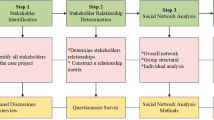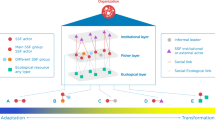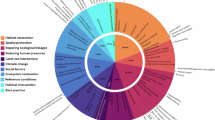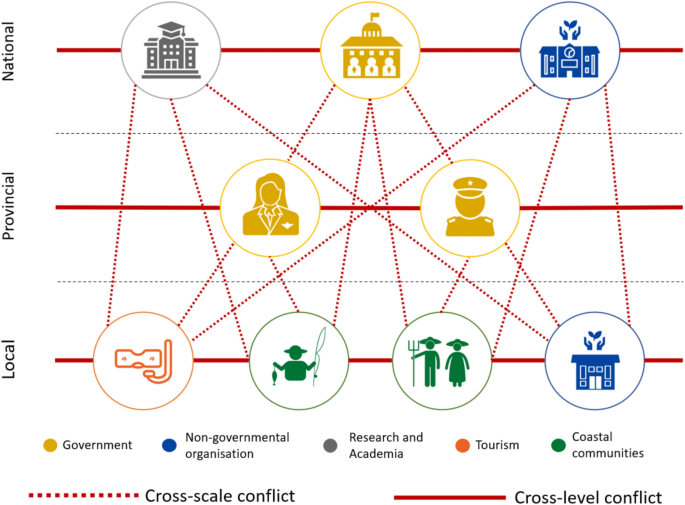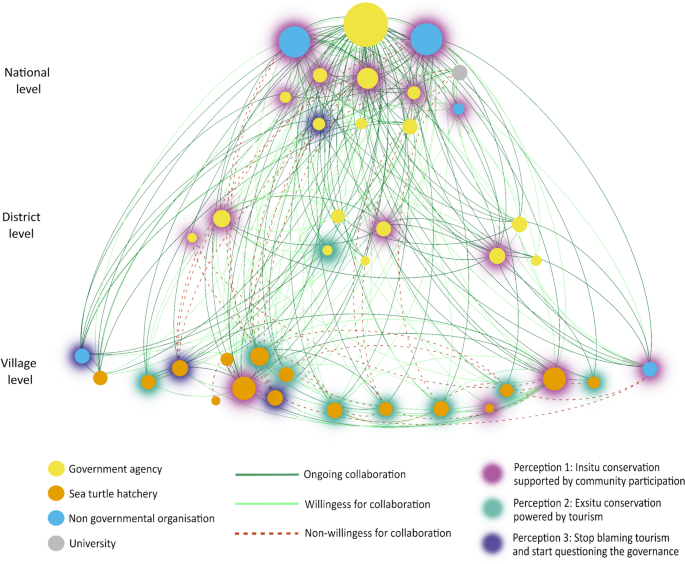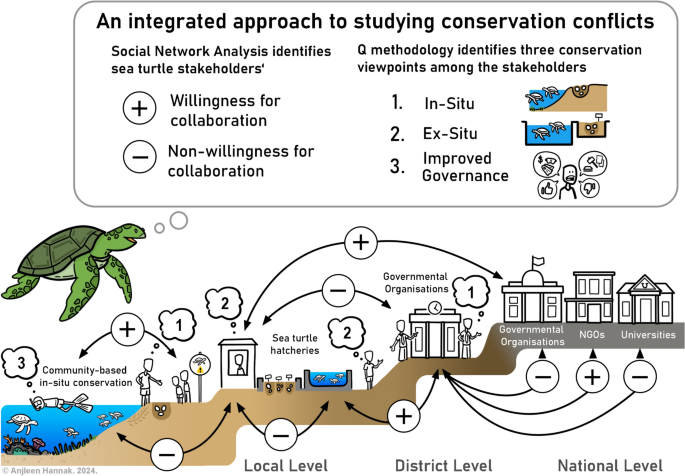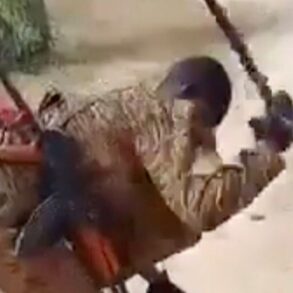Abstract
Conservation conflicts pose major challenges to biodiversity conservation, and addressing related stakeholder conflicts is gaining importance in the contemporary conservation discourse. We present an innovative approach to investigate conservation conflicts by combining Social Network Analysis and Q methodology. The study focuses on human–human conflicts among sea turtle conservation, tourism, and governance stakeholders in Sri Lanka. Our integrated approach simultaneously maps the collaborative relationships and the conservation viewpoints among 39 national, provincial, and local sea turtle stakeholders along the southern coast of Sri Lanka. Social Network Analysis reveals the dynamics of willingness and non-willingness for collaboration between stakeholders. Q methodology identifies three distinct clusters of conservation viewpoints. Perception 1 prioritises an integrated ecosystem approach to protect sea turtle eggs and the nesting beaches with community participation. Perception 2 promotes ex-situ conservation through sea turtle hatcheries, highlighting the economic benefits of sea turtle tourism. Perception 3 criticises the governance characterising the limited intersectoral collaboration and poor monitoring of the privately owned hatcheries. Mapping the conservation viewpoints within the stakeholder network highlights multi-scale conservation conflicts rooted in diverse stakeholder preferences and needs. Managing these conflicts is important for inclusive and effective sea turtle conservation and tourism in Sri Lanka.
Similar content being viewed by others
Introduction
Rapid biodiversity loss despite global conservation initiatives, poses significant implications for human well-being1. The urgency to address this challenge is evidenced by the failure to meet the 2010 targets of the Convention on Biological Diversity and by the unmet Aichi Biodiversity Targets in 20202,3. Implementation of conservation policies is often limited by competing discourses and disagreements among conservation stakeholders4. Conservation conflicts, rooted in varied goals, perceptions, and priorities of stakeholders often hinder conservation outcomes and they necessitate careful management and resolution5. For instance, increasing tensions among stakeholders over conservation can lead to governance challenges, wildlife mismanagement, or retaliatory action against wildlife that undermine biodiversity conservation efforts. However, human–human conflicts over conservation can also serve as a gateway for dialogue to improve decision-making and collective action in conservation6. Identifying relevant stakeholders and understanding their varying opinions is therefore an important step in addressing conservation conflicts7. Recognising the significance of addressing conservation conflicts, the Kunming-Montreal Global Biodiversity Framework (GBF), adopted Target 4 in 2022, which calls for measurable indicators on “Trends in effective and sustainable management of human-wildlife conflict and co-existence”8. Although GBF Target 4 focuses on managing interactions between people and wildlife, it highlights the need to study conservation conflicts, particularly stakeholder needs, priorities, and disputes. This study provides an integrated approach to studying the dynamics of stakeholder conflicts in conservation using a case study of sea turtle conservation conflict in Sri Lanka.
Sea turtles have faced human exploitation due to the unsustainable harvesting of eggs, shells, and other body parts for consumption and trade9. Additionally, stressors such as fisheries bycatch, habitat degradation, and climate change10,11,12have affected sea turtles, resulting in the decline of sea turtle populations13. In Sri Lanka, these threats are drastically affecting the nesting populations of sea turtles14. The use of decorative and functional objects carved from sea turtle carapaces has been valued globally in many cultures15. The expanding colonial networks in the seventeenth century paved the way for organised sea turtle shell trade across the world16. Sri Lanka played a part in the global trade where the colonial government provided rights to harvest turtle shells by leasing out the beaches during the nineteenth century17. Killing, consumption, and possession of sea turtles or their eggs is illegal under the Sri Lankan Flora and Fauna Ordinance (FFPO, 1938). Additionally, as a signatory of the Convention on International Trade in Endangered Species of Wild Fauna and Flora (CITES), Sri Lanka has banned the import and export of sea turtles and their products since 1979. While hunting for shell trade has reduced, consumption of eggs persists on a small scale in many regions despite legal protections18. Furthermore, the consumptive use of eggs has evolved into economic exploitation for sea turtle tourism through an informal egg buyback program mediated by privately owned sea turtle hatcheries in southern Sri Lanka19. The egg buyback programme involves the purchase of sea turtle eggs from local egg collectors, which are in turn relocated to hatcheries within or adjacent to beaches for ex-situ conservation20. An estimated 300,000 sea turtle eggs are relocated annually in the Galle district in Sri Lanka21. Egg relocation has been credited with conserving sea turtle eggs from threats such as human consumption, predation, and coastal development in many parts of the world12. Although the sea turtle hatcheries in Sri Lanka were initially started for conservation, currently the practices of many hatcheries are reflected as a commercial venture for the purpose of tourism19,20,21. This shift highlights the complex interplay between conservation and economic interests associated with sea turtle tourism, involving diverse stakeholders in Sri Lanka.
Sea turtle tourism (STT) has gained prominence among both tourism and conservation stakeholders due to its potential for non-consumptive alternative revenue for those involved22,23. Opportunities for employment and income generation facilitate community engagement and decrease direct consumption of sea turtles and their products24,25,26. The benefits of STT extend to education and awareness27, which is crucial, particularly in developing countries where sea turtle consumption is often driven by poverty and lack of awareness18,28,29. However, some aspects of sea turtle tourism on both water and land pose risks across the different life stages of sea turtles as well. In-water sea turtle observation activity such as snorkelling mostly occurs in shallow coastal areas where sea turtles aggregate for foraging30. Undesirable tourist behaviour in these sites can affect the feeding behaviour of sea turtles31. Rookeries with a high nesting density of sea turtles offer opportunities for ‘turtle walk’ or ‘turtle watch’ tours where tourists observe sea turtles on the beaches while they come ashore to lay eggs32. Such activities can disturb sea turtles during nesting or emergence process due to the use of flashlights and crowding33. Sea turtle hatcheries are commonly found in South and Southeast Asian countries19. They help attract tourists and support ex-situ protection of eggs from human consumption and natural predation34. In Sri Lanka, hatcheries retain sea turtle hatchlings in tanks for a few days along with a few juvenile and adult sea turtles as added attractions for tourists20. Their involvement in the collection, transportation, and incubation of eggs in ex-situ conditions raises concerns about implications on reproductive output when best practices are not followed35.
Sea turtles, as migratory megafauna, often transcend international boundaries crossing between the jurisdictions of multiple nations36. Conservation efforts such as alternative livelihood development to limit egg consumption and fisheries management to reduce bycatch have helped stabilise sea turtle populations in some areas37. However, the involvement of a variety of local, national, and international stakeholders in sea turtle conservation has led to diverse sea turtle conservation conflicts38. Human–human conflicts over sea turtle conservation often stem from strict protection measures involving restrictions such as limited access to resource systems within protected areas39, ban on consumptive activities40,41, and regulations in fisheries42. This creates conflicts among cross-scale stakeholders due to the lack of alignment between international/national conservation initiatives and local values and needs or cross-level conflicts due to competing interests among similar stakeholders (Fig. 1). Here, we present an innovative approach to investigate multi-scale conservation conflicts by combining two stakeholder-based methodologies, Social Network Analysis and Q methodology. This research aims to contribute to understanding stakeholder conflicts over sea turtle conservation in Sri Lanka by (i) identifying and assessing the collaborative network among stakeholders who are involved in sea turtle conservation, (ii) investigating the perceptions of the stakeholders on sea turtle conservation and management, and (iii) mapping stakeholders’ perceptions within their collaborative network.
Multi-scale conservation conflicts. A visual representation of the multi scale conservation conflicts among sea turtle stakeholders within the same governance or management scale (bold red line: cross-level conflicts) and different governance or management scales (dotted red line: cross-scale conflicts). This highlights the complexity of stakeholder conflicts at different levels and scales of sea turtle governance and management, a basis to emphasise the necessity for an integrated approach to studying these multi-scale conservation conflicts. The empirical evidence for this visual framework is derived from the specific case study presented in this research, supplemented by insights from a previous study on sea turtle conservation conflicts in the Caribbean basin38. Conceptual image created using Microsoft PowerPoint v.16.0.
Results
Social network analysis
The stakeholder network analysis identified 39 organisations and institutions involved in sea turtle governance, conservation, and management, categorised into four actor groups (government, non-governmental organisation, sea turtle hatchery, and university). The resulting stakeholder networks Fig. 2), organised by three levels of collaboration, provide insights into the complexities of the presence, absence, willingness, and non-willingness for collaboration among the stakeholders.
Collaboration networks of sea turtle stakeholders. (a) Overall network of sea turtle stakeholders featuring three levels of collaborative link between them. Subsequent figures show specific collaborative networks (b) Network of ongoing collaboration between the stakeholders, (c) Network of willingness for collaboration between the stakeholders, (d) Network of non-willingness for collaboration between the stakeholders. The stakeholder acronym expansions are provided in Supplementary Table 1. Networks created using Gephi v.0.10 (https://gephi.org/) in combination with Inkscape v.1.0.3 (https://inkscape.org/).
Ongoing collaboration
The ongoing collaboration network, characterised by a star formation, exhibits a high degree of centralisation with an overall low density of links between the actors (Fig. 2b). The national governmental authority, Department of Wildlife Conservation (DWC), holds a central position with mutual collaborative links to most actors. Considering the high betweenness centrality and eigenvector centrality, it is the most influential actor in the network of ongoing collaborations (Supplementary Table 3). Notably, other governmental authorities, at both national and provincial levels, show moderately low connectivity with other actors. In the governmental realm, there are no links between district-level offices of Department of Fisheries and Aquatic Resources (DFA), no link between the national (SLTDA) and provincial (RTB) tourism authorities, and weak links among coastal and marine environmental management authorities (CCRMD and MEPA). However, all these weakly connected governmental departments are linked to the central actor (DWC), emphasising its central governing role. Two national-level Non-Governmental Organisations (NGOs) (TCP and BCSL) are well connected with the governmental agencies but lack direct collaboration between them. The sea turtle hatcheries are the most marginal actors in the network of collaboration, and many of them are only connected with the DWC. Many sea turtle hatcheries have little or no connections within their group. Three isolated actors have been identified, including two sea turtle hatcheries and the district-level tourism actor (RTB).
Willingness for collaboration
The willingness for collaboration network is characterised by lower centralisation, featuring multiple central actors (Fig. 2c). Two national-level NGOs (TCP and BCSL) are the most centralised actors in the network, with high betweenness centrality and eigenvector centrality, suggesting their potential influence in fostering collaborative relationships among sea turtle management actors (Supplementary Table 3). These central NGOs show a willingness to bridge gaps by directing numerous connections to the private sea turtle hatcheries. Two key sea turtle hatcheries (H2 and H13) have been identified with a high indegree from other hatcheries and NGOs, highlighting their roles as gatekeepers between the private sector and other actors. Some sea turtle hatcheries express diverse interests by showing willingness to collaborate with NGOs (TCP AND BCSL), research-related actors (NARA and UNI), tourism-related authority (SLTDA), and the district-level offices of DWC. While these private actors are open to future collaborations with other actor groups, there is limited willingness to collaborate with actors of their type. Governmental authorities related to fisheries (DFA), coastal and marine environmental management (CCRMD and MEPA), law and order (SLP), and coast guard (SLCG) have little or no links with each other or other actors in the willingness for collaboration network.
Non-willingness for collaboration
The non-willingness network is characterised by a decentralised network, displaying low density and connectedness (Fig. 2d). Multiple central actors with few links shows non-willingness for collaboration between some sea turtle stakeholders. The network shows a predominant lack of willingness for collaboration between the private sea turtle hatcheries. Notably, all links in this network originate from the sea turtle hatcheries. A few sea turtle hatcheries expressed no willingness in collaborating with the NGOs, research-related actors, tourism authorities, the police department, and the coast guard. For instance, three hatcheries (H9, H12, H14) expressed non-willingness toward NGOs, three hatcheries (H5, H6, H14) toward a university, two hatcheries (H12, H14) toward NARA (a governmental research agency), two hatcheries (H6 and H12) toward RTB (a provincial-level tourism authority), and two hatcheries (H6, H12) toward the police department and the coast guard, respectively.
Q methodology
In Q methodology, a factor analysis is used to identify underlying patterns and similarities among the Q-sort dataset and delineate them into factors. The factors are similarly clustered Q-sorts based on their similarity in ranking of Q statements by the respondents. The factor analysis resulted in the extraction of three factors that explain 45% of the total variance (Table 1). Factor 1 explains 29% of variance with 19 out of 35 Q-sort loadings. Factor 2 explains 9% of variance with 11 Q-sort loadings. Factor 3 explains 7% of variance with 4 Q-sort loadings. The correlation of factor Z-score indicates that the three factors are significantly independent of each other. The combined interpretation of the three factors, their corresponding statements, and qualitative data has revealed the three distinct clusters of perceptions among the stakeholders about sea turtle conservation in Sri Lanka. The Q statements used for the interpretation of perceptions can be found in Supplementary Table 5. We describe each perception and its themes with a summarised title and supporting respondents’ quotes in Table 2.
Integrated results: multi-scale conservation conflicts
Integrating results from social network analysis and Q methodology allows us to visualise and map identified perceptions within the sea turtle actors’ network (Fig. 3). This integrated mapping helps us understand the distribution of actors’ perceptions across three spatial scales of sea turtle governance and management — the national, district (provincial), and village (local) levels. At the national level, governmental agencies and NGOs share a similar conservation opinion favouring ‘in-situ conservation supported by community participation’ (Perception 1), except for one actor who is self-critical of the governance (Perception 3). This suggests consensus among national-level actors on sea turtle management for conservation. Moving down the governance structure, at the provincial level, most intermediary governance actors continue to support in-situ conservation (Perception 1), except for one actor who prefer ex-situ conservation (Perception 2). However, a shift in perception occurs as we move down the governance structure, characterised by a preference for ex-situ conservation. At the local level, sea turtle hatcheries predominantly support ex-situ conservation along with sea turtle tourism (Perception 2), followed by support for in-situ conservation (Perception 1), and some actors criticising the governance (Perception 3). This indicates more diversified perceptions at the local level, marked by an increased lack of willingness for collaboration among actors. The integrated mapping of the social network and perceptions indicates polarised and conflicting viewpoints between the national-level actors and local actors.
Multi-scale conservation conflicts among sea turtle stakeholders in Sri Lanka. The network visualisation presents an integrated map of collaborative links (edges) between stakeholders (nodes) across three governance levels analysed through social network analysis. The node shadows represent three distinct perceptions identified using Q methodology. This integrated mapping reveals a shift in preferred conservation strategies across governance levels. At the national level, government and non-governmental organisations predominantly support in-situ conservation, while at the local level, sea turtle hatcheries largely favour ex-situ conservation. This polarised point of view between national and local stakeholders highlights the multi-scale conservation conflicts among the sea turtle stakeholders. Network created using Gephi v.0.10 (https://gephi.org/) in combination with Inkscape v.1.0.3 (https://inkscape.org/).
Based on the integrated mapping of perceptions across governance scales, the analysis of the three collaboration link types and perception types reveals distinct patterns emerging between stakeholder interactions based on their shared and differing perceptions (Fig. 3). The percentage of collaboration ties within and between perception groups is provided in Table 3. Ongoing collaboration is the most frequent among actors holding Perception 1 (24.22%), suggesting that stakeholders who prefer the in-situ conservation approach engage in stronger collaboration. Ongoing collaboration across different perception groups is generally low, with actors of Perception 1 and Perception 3 (5.47%) showing some interaction, while actors holding Perception 2 and Perception 3 exhibit no collaboration. Willingness for collaboration is most frequent across actors holding Perception 1 and Perception 2 (24.43%), indicating that stakeholders who prefer in-situ and ex-situ conservation approaches have potential for future collaborations, despite the low frequency of ongoing collaboration between them (3.12%). Expressed non-willingness for collaboration is highest among Perception 2 actors, indicating internal tensions among stakeholders who prefer ex-situ conservation. Additionally, non-willingness for collaboration is observed between actors of Perception 1 and Perception 2 (3.91%) and Perception 1 and Perception 3 (3.12%).
Discussion
Sea turtle stakeholder relationships: opportunities and challenges
Collaboration among conservation stakeholders within and across different scales is important for effective marine resource management43. Social Network Analysis provides insights into stakeholder positions and their influence in conservation decision-making, helping to identify opportunities to maintain and foster cooperation and enhance conservation outcomes44. Mapping the collaborative networks among the sea turtle stakeholders allowed us to assess their ongoing collaboration, potential for future collaboration, and lack of willingness for collaboration in southern Sri Lanka. The highly centralised ongoing collaboration, centred around a national-level governmental authority, suggests a clear governing body overseeing sea turtle conservation in Sri Lanka. Local actors directly managing sea turtles are well connected to this central actor. However, limited ongoing collaboration exists between sea turtle hatcheries and district-level governing authorities within the identified central governing actor, the Department of Wildlife Conservation (DWC), suggesting inadequate monitoring of hatcheries for best practices in ex-situ management. This indicates a formal and command-based relationship between the central governing body and sea turtle hatcheries, primarily involving permits and licensing. Additionally, we notice low connectivity between government authorities related to fisheries, coastal management, and tourism, as well as non-governmental sea turtle actors. This lack of inter-sectoral collaboration may hinder the implementation of comprehensive conservation strategies at the local level.
Weak collaboration is evident in the non-governmental realm, with limited collaboration between sea turtle hatcheries and no collaborative links among most NGOs. Notably, while NGOs express a willingness for future collaborations among each other, sea turtle hatcheries generally show clear unwillingness to collaborate, possibly due to competition and internal conflicts related to sea turtle tourism22. The marginal network position of the sea turtle hatcheries is not a case of exclusion faced by local actors in coastal systems45, but rather due to their generally limited interest in collaboration. Despite these challenges, the willingness for collaboration network indicates that a few sea turtle hatcheries express a willingness to collaborate with various entities. Central positions of a few NGOs, sea turtle hatcheries, and governmental agencies in the willingness for collaboration network suggest potential brokers, capable of fostering collaboration and bridging gaps between unconnected actors. Leveraging this openness for collaboration could strengthen partnerships and enhance conservation initiatives, particularly if facilitated by the identified non-governmental brokers46.
Sea turtle stakeholder perceptions and conservation conflicts
Our findings suggest a debate among stakeholders regarding the preferred approach for sea turtle conservation in Sri Lanka. Approximately 48% support in-situ conservation, while 28% prefer ex-situ conservation through hatcheries. Perception 1, promoting the protection of sea turtle eggs within the beaches along with community participation, garners cross-scale and cross-level support, particularly from central governmental and non-governmental actors. This collective support for community-based conservation is a strength, as community participation has been demonstrated to be a key factor for effective sea turtle conservation in different countries, including Sri Lanka26,29,47,48. This consensus among the central actors could facilitate streamlined policy formulation and coordinated conservation efforts. In contrast, local actors express diversified opinions, with all three perceptions being prevalent. This could be due to the plurality of values, interests, and needs among them49. A system with multiple stakeholders holding strong opinions in shared spaces is prone to conservation conflicts5, which may explain the cross-scale unwillingness to collaborate among many sea turtle hatcheries. The shift in perception down the governance structure indicates a preference for ex-situ conservation and sea turtle tourism among these private actors managing sea turtles. This suggests a gap between conservation strategies proposed by formal authorities and those implemented by privately owned sea turtle hatcheries, leading to a looming conservation conflict between decision-makers and local actors. The consensus at the national level, promoting an in-situ conservation strategy, overlooks local needs and the opinions of tourism actors. This may hinder local engagement and knowledge exchange, affecting the conservation outcome50. This conservation dispute, with complaints of potential income loss, limited conflict resolution attempts in the past, and willingness for collaboration among some stakeholders, represents a Level 1 conservation conflict51. If left unresolved, such disputes can escalate into higher intensity or trigger more conflicts among stakeholders, which may create resentment between stakeholders and negatively affect their involvement in sea turtle conservation.
Perception 2, centred on ex-situ conservation, promotes sea turtle tourism and ‘voluntourism’ in funding conservation activities. This viewpoint, shared by many sea turtle hatcheries, neglects community participation, stigmatising local communities as ‘not supportive’. The preference for international volunteer tourists may result in localised decision-making favouring international actors over local communities. For instance, the free labour associated with ‘voluntourism’ could reduce local employment in hatcheries52. Prolonged implementation of ex-situ strategies with sea turtle tourism by private actors may instigate conflicts among the local communities53. Such socio-political conflicts, along with the identified conservation conflict, among cross-scale or cross-level actors impede effective sea turtle conservation across local, national, and global scales54. Given that Sri Lanka’s beaches are important nesting sites for 3 out of 11 threatened regional populations of sea turtles in the Northeast Indian Ocean55, the identified conservation conflicts pose critical challenges for sea turtle conservation in the region.
Increased privatisation over sea turtle management in Sri Lanka
We identified 16 privately owned sea turtle hatcheries in southern Sri Lanka, including two that were undocumented prior to this study21. Since 2018, two new hatcheries have been set up and one closed permanently (Supplementary Fig. 4). While these hatcheries represent 41% of the stakeholders within the mapped sea turtle management network, they have minimal collaboration with other stakeholders. This lack of collaboration, due to the identified differing views, suggests most hatcheries operate independently with limited external interventions. This aligns with previous findings that hatchery management staff lack scientific training, relying on their experience to manage sea turtles20. Our findings identify non-willingness for collaboration among hatcheries despite their general shared preference for ex-situ conservation. This suggests that conflicts exist between the sea turtle hatcheries, which could be due to their tourism-related competition. The high prevalence of sea turtle hatcheries in the network highlights increased unregulated privatisation in the sea turtle management network. While hatchery-based conservation has revived some regional populations globally12,56, the long-term effects of ex-situ conservation strategies on these recovered sea turtle populations remain uncertain. Concerns include the prolonged time between egg collection and relocation, high nest density, and hatchling retention in tanks21, negatively impacting hatching success, reproductive output, sex ratio, and hatchling fitness57,58,59.
Perception 2 suggests that ex-situ conservation through hatcheries in Sri Lanka heavily relies on tourism for financial support. These hatcheries derive their income completely from tourist visits, volunteer tourists, and donations19. Nature-based tourism practices that have negative effects on wildlife are mostly associated with tourists’ satisfaction and pleasure60. Undesirable hatchery practices, driven by tourism pressures, such as prolonged retention of hatchlings in tanks and maintaining high hatchling density, may intensify among business competitors aiming to attract more tourists. The income generated through tourism is used by the sea turtle hatcheries to manage an egg buyback program, that has created an economic market for sea turtle eggs on Sri Lanka’s southern coast19. Unlike Malaysia, where a similar program is regulated by national and state-level legislation40. Sri Lanka’s egg buyback program controlled by the hatcheries, is completely privatised and lacks a legal framework and best practice guidelines. Approximately 120 egg collectors supply eggs to hatcheries in the Galle district of southern Sri Lanka20. By controlling the egg buyback program, the privately-owned hatcheries may act as gatekeepers of Local Ecological Knowledge on sea turtle nesting sites61, primarily held by the egg collectors of the Galle District.
In Perception 2, it is noted that the sea turtle hatcheries’ operations were severely impacted during the 2020–2022 global pandemic due to the failure of tourism. Economic shocks stemming from political crises, such as the 30-year civil war, disasters like the 2004 tsunami, and global crises like the 2020–22 pandemic have severely impacted Sri Lanka’s tourism industry in the past62,63,64. According to Perception 2, the hatcheries could not afford to buy eggs from the egg collectors due to the lack of tourism-related income during the COVID-19 pandemic. Such temporary halts in the egg buyback program controlled by the hatcheries could have negative impacts on wild sea turtle eggs and hatchlings due to increased predation by feral dogs, beach erosion, disorienting light pollution, and illegal poaching and consumption65. Furthermore, egg collectors, who depend on hatcheries for their income, may experience financial hardship during such periods. Reports from a few hatchery owners who support Perception 2 suggest that this may have led to an increase in illegal sales of sea turtle eggs elsewhere or direct consumption. This raises questions about the viability of the private sea turtle hatcheries and the egg buyback program that they control in Sri Lanka’s southern coast. Therefore, in addition to undesirable management practices, the instability of tourism-dependent sea turtle hatcheries poses an additional concern for sea turtle conservation in Sri Lanka.
Towards cooperative and inclusive governance for sea turtle conservation in Sri Lanka
The increase in unregulated privatisation in sea turtle management, discussed in Perception 3, ‘Stop blaming tourism and start questioning governance’, suggests that a few sea turtle stakeholders view the related governance as particularly ineffective and non-inclusive. This perceived poor governance is considered to perpetuate the existing trade-off between risks and benefits in ex-situ sea turtle conservation strategy dependent on tourism. Comparably, reported poor decision-making in Sri Lanka due to a lack of sectoral collaboration has impacted the management of mangroves66and marine protected areas67. Similar issues persist among the identified governmental authorities particularly at the provincial or district level, responsible for monitoring the sea turtle tourism stakeholders. The divergence from the recommended in-situ conservation strategy to the largely implemented hatchery-based ex-situ conservation indicates the decision makers’ lack of power to execute desired conservation actions in Sri Lanka. It further highlights the influence of private sea turtle hatcheries in managing sea turtles despite their largely marginal network positions. Given the conservation conflict’s root in differing management strategies, addressing diverse sea turtle stakeholder interests is crucial for conflict resolution and holistic conservation.
Although the ‘conservation through capitalism’ is a globally criticised perception68, it finds strong local support in Sri Lanka. This support stems from a combination of economic interest and a belief that hatcheries are important for sea turtle conservation due to perceived governmental inaction. Particularly, the role of the private sea turtle hatcheries is critical considering the vulnerability of the Sri Lankan beaches to coastal erosion, during which egg relocation is the only option69. This emphasises the need to legitimise the sea turtle hatcheries involved in sea turtle tourism, despite their informal status. Perception 2, ‘Ex-situ conservation powered by tourism’, advocates licensing to legitimise and monitor the sea turtle hatcheries, ensuring adherence to best practices. We recommend collaborative efforts between the Department of Wildlife Conservation (DWC) and Tourism Development Authorities in monitoring sea turtle hatcheries, incorporating guidelines from both conservation and tourism perspectives. The guidelines should include best practices for egg collection and relocation, nest density, hatchling handling and release, data collection and reporting, and visitor management35. The National Aquatic Resources Research and Development Agency (NARA) could support the Department of Wildlife Conservation in training the hatchery management to follow and implement the above best practices. Enforcement should be carried out jointly by the district wildlife ranger and regional tourism officers regularly with penalties for violations, and revocation of licences for repeated violation. Despite benefits, the licencing mechanism should be implemented with caution, to prevent it from encouraging the establishment of new hatcheries and undermining in-situ conservation efforts.
The identified stakeholder conflict over preferred sea turtle conservation action represents a Level 1 conservation conflict, which can be addressed through negotiation and the co-creation of practical solutions that are agreeable to all stakeholders51. A potential approach is the establishment of a multi-stakeholder forum for sea turtle conservation and tourism, overseen by the Department of Wildlife Conservation. The forum, comprising representatives from governmental agencies, NGOs, hatcheries, and local communities, could serve as a platform to discuss stakeholder-specific needs and challenges, build consensus, and negotiate strategies. Such multi-stakeholder forums have been successfully implemented in other countries to improve stakeholder participation, knowledge exchange, and conflict resolution in sea turtle conservation25,44,70,71. An annual meeting at the end of the nesting season could be organised to review the nesting trends, assess the successes and challenges of different conservation strategies, and facilitate scenario planning. This forum would also encourage hatcheries to maintain and document egg relocation-related data and tourism-related records. At the local level, hatcheries and local authorities could establish co-management committees that include egg collectors and other community members. This would enable them to explore opportunities for in-situ conservation and turtle-watch tourism, while overseeing local surveillance efforts to prevent poaching23,26.
The formal recognition of the sea turtle hatcheries through licensing under the Fauna and Flora Protection Ordinance (FFPO) can be the first step towards this, as it can facilitate positive engagement with the tourism stakeholders, breaking the existing communication barriers. The hatcheries possess valuable local knowledge of nesting sites and practical knowledge of hatchery management, which could support policymakers to design guidelines and strategic plans. NGOs like the Turtle Conservation Project (TCP), Bio Conservation Society (BCS), and The Pearl Protectors (TPP) have experience in establishing co-management strategies with local authorities and community members for sea turtle conservation in other parts of Sri Lanka26,72. This strategic knowledge from the NGOs could help the private hatcheries in establishing the recommended co-management committees in the Galle district73. Leveraging the identified central and marginalised stakeholders, including the NGOs and hatcheries, to bridge the existing knowledge gaps and enhance cooperation, is vital74. Such cross-sectoral collaborations could pave the way for initiatives balancing ecologically recommended in-situ conservation and economically required ex-situ strategies through collective action.
Outlook: An integrated approach to studying multi-scale conservation conflicts
Our study reveals a critical conservation conflict among the sea turtle conservation and tourism stakeholders in southern Sri Lanka. Drawing on prior studies on stakeholder perceptions in natural resource management75,76,77, the identified conservation viewpoints show clear polarisation, influenced by the varied preferences and needs of the stakeholders involved in sea turtle management. Examining divergent viewpoints among conservation stakeholders is important to facilitate conflict resolution and co-design governance strategies that accommodate specific needs and preferences within different opinion clusters78. The misalignment between the national-level stakeholders advocating for in-situ conservation and the local tourism-driven ex-situ conservation implemented by the sea turtle hatcheries is a critical conservation conflict. These polarised viewpoints underscore the longstanding governance challenges and gaps between global expectations and local needs in sea turtle conservation54. Despite global priorities and recommendations set a decade ago36, unresolved regional or local conservation conflicts pose a significant setback for conserving sea turtles that traverse international boundaries. In addition to studying the dynamics of this multi-scale conservation conflict, our integrated approach has enabled us to identify collaboration opportunities among the stakeholders to foster cooperation and conflict resolution. Based on our findings, we have recommended targeted interventions such as the establishment of a provincial multi-stakeholder forum, development of local co-management committees, and fostering greater transparency in governance, particularly in licensing the private hatcheries and auditing the hatchery practices. These recommendations, focusing on collective action, would enhance cooperation among stakeholders and minimise conflicts through consensual agreements and negotiation of strategies, enhancing conservation outcomes locally.
Methodologically, we present an integrated approach to studying multi-scale conservation conflicts and cooperation by combining Social Network Analysis (SNA) and Q methodology (Q) (Fig. 4). The combination of SNA and Q has been thought of previously to study stakeholder dynamics and their perspectives in environmental and sustainability sciences79,80,81,82. A similar combined interpretation of network analysis and discourse analysis has been conducted to study stakeholder conflicts in livestock and agriculture management79. The novelty in our study remains in the integration of stakeholder perceptions on their collaboration networks arranged across national, provincial, and local scales. The mixed-method approach has allowed us to understand the relational and perceptual dynamics of collaboration and conflicts among a group of conservation stakeholders. A key strength of our method is that it identifies conservation conflicts without directly posing questions about conflicts, reducing social desirability bias or “interviewer-pleasing” responses, a well-documented challenge in conflict research83. Instead, by mapping stakeholders’ willingness and non-willingness for collaboration along with their worldviews, we infer conservation conflicts, offering a non-intrusive yet systematic way to assess stakeholder conflicts. Beyond this case study, our integrated approach contributes to the field of conservation science, by offering a methodological framework to study multi-scale conservation conflicts. This approach would support the assessment of dynamics of conflicts over conservation to inform conflict management strategies51. This is particularly relevant to the Kunming-Montreal Global Biodiversity Framework (GBF) Target 4, which calls for managing human-wildlife conflicts and promoting coexistence. We recommend our integrated approach to study and address conservation conflicts and cooperation for enhanced conservation output in diverse social-ecological systems.
An integrated approach to studying multi-scale conservation conflicts. The figure summarises our novel approach, integrating Social Network Analysis and Q methodology, to study multi-scale conservation conflicts and cooperation. Our mixed-methods approach has enabled us to understand both the relational and perceptual dynamics of stakeholder conflicts in conservation by mapping stakeholder perceptions within their collaborative networks. The illustration also serves as a pictorial representation of the diverse sea turtle stakeholders and their dynamics in southern Sri Lanka. Original illustration conceptualised by the first author and designed by Anjleen Hannak, licensed under CC BY-ND 4.0.
Methodology
This study integrates two stakeholder-based methods, Social Network Analysis and Q methodology to examine stakeholder collaboration networks and their perceptions of sea turtle conservation. The study was performed in accordance with the ethical standards set by the 1964 Declaration of Helsinki. Ethical approval for this study was waived by the Ethics Review Committee (ERC) of University of Ruhuna, Sri Lanka, due to the expert nature of the stakeholders who took part in the interviews. Nevertheless, following ERC’s recommendation, informed consent was obtained from all participants.
Overview of social network analysis and Q methodology
Social Network Analysis (SNA) is a methodological approach used to understand the structure of social systems focusing on relationships and the strength of interactions between human entities84. A system studied using SNA is represented in the form of a network composed of nodes (individuals, institutions, and other entities) and ties or edges (directed or undirected relationships) among the nodes. In conservation science, SNA helps to identify key stakeholders, assess their position and influence, and analyse the strengths and weaknesses of their networks85,86. Its ability to visually and quantitatively map stakeholder interactions makes it an ideal tool to study collaboration and conflict dynamics among conservation stakeholders87.
Q methodology (Q) is used to study subjective viewpoints about specific topics88. Using a combination of quantitative and qualitative analytical approaches, Q empirically identifies and delineates perceptions, discourses, and opinions among people89. It provides a defined procedure to engage a small number of respondents, as Q focuses on studying the plurality of subjectivity and not their representativity in a population90. Therefore, it is well suited to explore perceptions among a group of stakeholders involved in any system, providing insights into priorities, agreements, and disagreements89. In recent years, Q is increasingly applied to inform management strategies, policy planning and appraisal, conflict resolution, and critical reflection in the field of conservation science91.
Integrating SNA and Q methodology offers a robust mixed-methods approach for studying conservation conflicts. While SNA reveals stakeholder networks and their structural dynamics, Q complements this by capturing the perceptions of those stakeholders. The two methods have been combined previously to explore aspects of stakeholder dynamics in sustainability sciences79,80,81,82. Building on these studies, we integrated SNA and Q to examine multi-scale conservation conflicts among the sea turtle stakeholders in Sri Lanka. We describe the steps involved in our mixed methods approach below.
Social network analysis: data collection, visualisation, and analysis
An initial list of 34 stakeholders involved in sea turtle conservation and/or tourism along the southern coast of Sri Lanka was created through key informant interviews in August 2021. The key informant interviews were conducted with the founder of Turtle Conservation Project, a non-governmental organisation with over 30 years of sea turtle conservation experience in Sri Lanka, and a district-level director of Department of Wildlife Conservation. An additional five stakeholders were added to the initial list during the SNA interview conducted in March–May 2022. We identified 39 organisations, institutions, and agencies (hereafter referred to as stakeholders) belonging to four actor groups (government, non-governmental organisation, sea turtle hatchery, and university) in southern Sri Lanka (Supplementary Table 1). Thirty-six respondents (92.31%) representing the identified stakeholders participated in face-to-face or online interviews (Supplementary Table 2) to assess the collaborative relationship using the score in Table 4. Following66, we described collaboration as collective work to implement shared projects, coordinating activities, and sharing information and resources regarding sea turtle conservation, management, and tourism.
We used Gephi v.0.10, a specialised open-source software for SNA, for all network visualisation, calculation, and analysis92. The sea turtle stakeholders’ relationship data was manually entered as nodes and edges in the data laboratory panel of Gephi v.0.10. Networks were visualised using the ForceAtlas2 layout algorithm, which plots the network by positioning central and marginalised stakeholders based on their tie strengths and connectivity93. For improved clarity, minor manual adjustments of nodes were made to prevent edge overlaps in the plotted networks. An overall network and three relationship-specific networks were plotted to represent ongoing collaboration, willingness for collaboration, and non-willingness for collaboration among the sea turtle stakeholders (Fig. 2).
To analyse stakeholders’ positions and influence in each collaborative network type, node-level centrality measures were calculated94. This included: (i) Degree centrality: To identify actors with most or least links based on their total numbers of edges; (ii) Betweenness centrality: To identify bridging actors based on the number of times a node falls along the shortest paths between two unrelated nodes; (iii) Eigenvector centrality: To identify influential actors based on their connectivity with central actors95. These node-level metrics were calculated using the in-built network statistics tools in Gephi v.0.1096. The results were extracted for comparative analysis and interpreted in relation to different collaboration networks (Supplementary Table 3).
Q methodology: data collection and analysis
The data collection followed the recommended steps outlined for Q studies in conservation science91. The concourse, which is the body of information related to our topic of interest, was developed through scientific and grey literature reviews, institutional/organisational websites, and key informant interviews with a few stakeholders. The scientific literature search was carried out on Web of Science and Google Scholar using the following keywords: “Sea turtle”, “Conservation”, “Management”, “Tourism”, “Stakeholders”, and “Sri Lanka”. The key informant interviews with the founder of Turtle Conservation Project, a wildlife ranger, and owners of two sea turtle hatcheries were conducted in August 2021 to collect relevant information for the concourse at a local context relevant to the case study.
Following this, a structured filtering process was undertaken to reduce the concourse to a manageable set of statements under six themes: 1. Law enforcement, 2. Research and Monitoring, 3. Sea turtle hatcheries and management, 4. In-situ conservation, 5. Community involvement and public awareness, and 6. Sea turtle tourism. Themes 1–5 are specific objectives outlined in the National Marine Turtle Conservation Action Plan of Sri Lanka developed in 200518 and theme 6 was added considering its relevance in sea turtle conservation in the study area. A ‘Q-set’ of 48 statements derived from the concourse was prepared (Supplementary Table 5). Pilot tests with two participants helped to refine some statements for clarity and comprehension. These statements were then translated into Sinhala and Tamil, the official languages of Sri Lanka ensuring inclusive participation, by minimising linguistic and cultural limitations.
Interviews were conducted with 35 respondents (29 from SNA) related to sea turtle governance, conservation, and tourism. The respondents representing the sea turtle stakeholders (from SNA) included divisional officers and district-level directors of governmental agencies, directors and founders of non-governmental organisations, and owners of sea turtle hatcheries. An additional 6 respondents involved in other forms of sea turtle tourism including representatives of an egg collector, a snorkelling gear rental shop, scuba dive school, a whale watching company, a resort owner, and a volunteer tourist were included. These respondents in addition to the 29 sea turtle stakeholders were added to include the opinion of diverse sea turtle tourism stakeholders beyond sea turtle hatcheries in the region. Participants sorted (ranked) the 48 statements in a grid based on their level of agreement: + 5 for the most agreed statements, – 5 for the most disagreed statement. The statements were printed and laminated into cards, and the grid was printed as an A3-sized banner (Supplementary Fig. 3). A post sorting interview was conducted to validate participants’ rationale for sorting (e.g.,opinions on statements sorted at extremes) and to collect additional qualitative information96,97.
Q Method software (available at: https://qmethodsoftware.com) was used to conduct the factor analysis using the following steps98. The dataset was initially organised in PQ method software before importing it into the Q method software91. A correlation matrix using Pearson correlation was calculated to measure the linear association between all the Q sorts (n = 35). Principle component analysis was used to group the Q sorts into a manageable number of factors based on their similarity in sorting. Initially, 8 un-rotated factors were obtained with an eigenvalue (EV) > 1. We used a varimax rotation which focuses on a mathematical solution to make sure that the factors explain the maximum study variance89. Following the factor rotation, the factors were auto flagged with a majority of common variance to determine the number of defining Q sorts significantly associated with each factor at p < 0.01 (Supplementary Table 4). Based on the minimum requirement of 2 significantly loaded Q sort within each factor we decided to retain 3 factors for factor interpretation99. The extracted 3 factors explained 45% of the study variance which passes the threshold of 35–40%91. The three factors were independently interpreted by examining the strongly agreed statements (+ 5 and + 4), strongly disagreed statements (−5 and −4), and the distinguishing statements attributed within each factor. The Q statements used for the interpretation of perceptions can be found in Supplementary Table 5. The interpretation of the content and patterns of statement rankings within each factor formed the basis for developing thematic narratives to explain the identified perceptions91. To further refine and validate these interpretations, qualitative information and rationale documented during post-sorting interviews were incorporated. The quotes from the respondents clustered within each factor were used to provide contextual insights and strengthen the identified perceptions95,97.
Mixed-methods approach: integration, visualisation, and analysis
To explore the dynamics of multi-scale conservation conflicts among the sea turtle stakeholders of southern Sri Lanka, the results from the two methods were integrated and interpreted. This was done by visually mapping the stakeholder perceptions within the stakeholder network. First, a multi-level stakeholder network using the relationship data of the three collaboration types was plotted in Gephi v.0.10. The nodes representing the sea turtle stakeholders, were manually delineated into three horizontal sections to position them across national, district, and local levels. The muti-scale network plot was exported as an SVG file and further developed using Inkscape v.1.0.3. To integrate the three perception types in the multi-scale network, the in-built “Shadows and Glows” feature in Inkscape v.1.0.3 was used to build coloured shadows around each node, indicating the respective stakeholder’s perception in the network (Fig. 3).
To identify and interpret patterns in the distribution of stakeholder perceptions across governance levels and actor types, we performed a descriptive analysis of the network. The distribution of perception types was examined within and across each of the three governance levels. To quantify the relationship between stakeholder perceptions and collaboration types, we calculated the percentage of each collaboration level within and across the three perception groups. The dplyr package100 in R software v.4.0.2 was used to aggregate the data and calculate the percentage of edges within and between the perception groups (Table 3). The results were interpreted to identify the relationship between stakeholder perceptions and the collaboration levels.
Limitations and constraints
Our mixed-method approach has presented some constraints and limitations. The combined interview, involving structured interview for SNA and ranking and post-sorting interview for Q, was a time-consuming process (approximately 2–3 h). This negatively affected the concentration of some respondents, as they had to take breaks in between to attend phone calls or other work. After noting this initial constraint, we informed the time requirement upfront or tried to get interview appointments during the non-working time of the respondents.
The statement preparation involved the concourse development guideline recommended for Q studies in ecology and conservation91. In addition to a scoping review of literatures, reports, and institutional websites, we used key informant interviews to prepare context-specific statements to the case study. The interviews with a limited number of key informants may have introduced biased statements, possibly resulting in overrepresentation of certain local viewpoints in the concourse. However, this engagement involved four individuals representing key stakeholder types (NGO, Governmental agency, and hatchery) with decades of experience in the case study region. Their input during the concourse development is considered important despite the possibility of being biased, as they are critical actors in the system20,21,26. The use of additional concourse sources, including a comprehensive review of relevant literature and reports, provided broader perspectives and helped to balance the potentially biased input from the key informants.
A key step in Q is the interpretation of factors through the thematic analysis of statement ranking pattern and develop a narrative to describe the shared viewpoint of respondents who loaded significantly on a factor. While this interpretation is guided by the ranking data, it involves the researcher’s judgement and is subjected to potential bias, a known limitation in Q methodology90. To strengthen the validity of our interpretation, the qualitative data collected during the post-sorting interview was included in the thematic analysis process. Additionally, the participant observation and on-ground experience of the first author helped to analyse and build the narratives, and efforts were made to mitigate bias through validation of results by co-authors with local and international expertise on conservation science. Future studies could incorporate open-ended questions to the post sorting interview phase to capture respondent’ values, preferences, and challenges on the topic of interest. Content analysis of the qualitative data could also provide a more structured and objective measure of the themes represented in each factor. However, this could add to the discussed time constraints involved in this integrated approach.
Data availability
The datasets used in this study are available as supplementary files and have been organised and anonymised for confidentiality. The node, edge and relational data used in the Social Network Analysis are available in Supplementary Dataset 1. The Q statements, Q-sort data, and factor analysis output used in the Q methodology are available in Supplementary Dataset 2.
References
-
Cardinale, B. J. et al. Biodiversity loss and its impact on humanity. Nature 486, 59–67. https://doi.org/10.1038/nature11148 (2012).
-
Convention on Biological Diversity. Conference of the Parties Decision X/2: Strategic plan for biodiversity 2011–2020. CBD (2010). Available at: www.cbd.int/decision/cop?id=12268.
-
Tittensor, D. P. et al. A mid-term analysis of progress toward international biodiversity targets. Science 346, 241–244. https://doi.org/10.1126/science.1257484 (2014).
-
Marshall, K., White, R. & Fischer, A. Conflicts between humans over wildlife management: on the diversity of stakeholder attitudes and implications for conflict management. Biodivers. Conserv. 16, 3129–3146. https://doi.org/10.1007/s10531-007-9167-5 (2007).
-
Redpath, S. M. et al. Understanding and managing conservation conflicts. Trends Ecol. Evol. 28, 100–109. https://doi.org/10.1016/j.tree.2012.08.021 (2013).
-
Young, J. C. et al. The role of trust in the resolution of conservation conflicts. Biol. Conserv. 195, 196–202. https://doi.org/10.1016/j.biocon.2015.12.030 (2016).
-
Redpath, S. M., Gutiérrez, R. J., Wood, K. A. & Young, J. C. Conflicts in Conservation. (Cambridge University Press, 2015). https://doi.org/10.1017/CBO9781139084574
-
McGowan, P. J. K. et al. Understanding and achieving species elements in the kunming-montreal global biodiversity framework. Bioscience 74, 614–623. https://doi.org/10.1093/biosci/biae065 (2024).
-
Garland, K. A. & Carthy, R. R. Changing taste preferences, market demands, and traditions in Pearl Lagoon, Nicaragua: A community reliant on green turtles for income and nutrition. Conserv. Soc. 8, 55. https://doi.org/10.4103/0972-4923.62675 (2010).
-
Fuentes, M. M. P. B., Limpus, C. J. & Hamann, M. Vulnerability of sea turtle nesting grounds to climate change. Glob. Chang. Biol. 17, 140–153. https://doi.org/10.1111/j.1365-2486.2010.02192.x (2011).
-
Wallace, B. P. et al. Global patterns of marine turtle bycatch. Conserv. Lett. 3, 131–142. https://doi.org/10.1111/j.1755-263x.2010.00105.x (2010).
-
Mazaris, A. D., Schofield, G., Gkazinou, C., Almpanidou, V. & Hays, G. C. Global sea turtle conservation successes. Sci. Adv. 3, e1600730. https://doi.org/10.1126/sciadv.1600730 (2017).
-
The IUCN Red List of Threatened Species. IUCN (2024). Available at: https://www.iucnredlist.org.
-
Kapurusinghe, T. Status and conservation of marine turtles in Sri Lanka. in Marine Turtles of the Indian Subcontinent (eds. Shanker, K. & Choudhury, B. C.) 173–187 (Universities Press, Hyderabad, India, 2006).
-
Frazier, J. Prehistoric and ancient historic interactions between humans and marine turtles. in The Biology of Sea Turtles, Volume II (eds. Lutz, P. L., Musick, J. A. & Wyneken, J.) 2, 1–38 (CRC Press, 2002).
-
Chaiklin, M. Imports and autarky: Tortoiseshell in early modern Japan. in Luxury in Global Perspective: Objects and Practices, 1600–2000 218–241 (Cambridge University Press, 2016). https://doi.org/10.1017/9781316257913.009
-
Hewavisenthi, S. Exploitation of marine turtles in Sri Lanka: Historic background and the present status. Mar. Turtle Newsl. 48, 14–19 (1990).
-
Rajakaruna, R. S. et al. Sea turtle conservation in Sri Lanka: Assessment of knowledge, attitude and prevalence of consumptive use of turtle products among coastal communities. Indian Ocean Turtle Newsl. 10, 1–13 (2009).
-
Tisdell, C. & Wilson, C. Do open-cycle hatcheries relying on tourism conserve sea turtles? Sri Lankan developments and economic-ecological considerations. Environ. Manage. 35, 441–452. https://doi.org/10.1007/s00267-004-0049-2 (2005).
-
Rajakaruna, R. S., Ekanayake, E. M. L., Kapurusinghe, T. & Ranawana, K. B. Sea turtle hatcheries in Sri Lanka: Their activities and potential contribution to sea turtle conservation. Ind. Ocean Turt. Newsl. 17, 2–12 (2013).
-
Phillott, A. D., Hewapathiranage, S. & Rajakaruna, R. S. Unregulated numbers and management practices of sea turtle hatcheries: An ongoing concern in Sri Lanka. Ind. Ocean Turt. Newsl. 27, 8–17 (2018).
-
Senko, J., Schneller, A. J., Solis, J., Ollervides, F. & Nichols, W. J. People helping turtles, turtles helping people: Understanding resident attitudes towards sea turtle conservation and opportunities for enhanced community participation in Bahia Magdalena. Mexico. Ocean Coast. Manag. 54, 148–157. https://doi.org/10.1016/j.ocecoaman.2010.10.030 (2011).
-
Rathnayake, R. M. W. ‘Turtle watching’: A strategy for endangered marine turtle conservation through community participation in Sri Lanka. Ocean Coast. Manag. 119, 199–207. https://doi.org/10.1016/j.ocecoaman.2015.10.014 (2016).
-
Campbell, L. M. Use them or lose them? Conservation and the consumptive use of marine turtle eggs at Ostional. Costa Rica. Environ. Conserv. 25, 305–319. https://doi.org/10.1017/s0376892998000393 (1998).
-
Madrigal-Ballestero, R. & Jurado, D. Economic incentives, perceptions and compliance with marine turtle egg harvesting regulation in Nicaragua. Conserv. Soc. 15, 74. https://doi.org/10.4103/0972-4923.201392 (2017).
-
Kapurusinghe, T. Sustainable use of sea turtles benefiting the local community in Rekawa Sanctuary, Sri Lanka. In Sea Turtle Research and Conservation (ed. Nahill, B.) 3–13 (Academic Press, 2021). https://doi.org/10.1016/b978-0-12-821029-1.00001-5
-
Smith, J. R. et al. Public sea turtle watches serve as effective environmental education. Environ. Educ. Res. 25, 292–308. https://doi.org/10.1080/13504622.2018.1509300 (2019).
-
Mancini, A. et al. To poach or not to poach an endangered species: Elucidating the economic and social drivers behind illegal sea turtle hunting in Baja California Sur. Mexico. Hum. Ecol. 39, 743–756. https://doi.org/10.1007/s10745-011-9425-8 (2011).
-
Poti, M. et al. Changing trends and perceptions of sea turtle egg consumption in Redang Island, Malaysia. Ecol. Soc. https://doi.org/10.5751/es-12717-260414 (2021).
-
Hazel, J., Lawler, I. R. & Hamann, M. Diving at the shallow end: Green turtle behaviour in near-shore foraging habitat. J. Exp. Mar. Bio. Ecol. 371, 84–92. https://doi.org/10.1016/j.jembe.2009.01.007 (2009).
-
Smulders, F. O. H., O’Shea, O. R. & Christianen, M. J. A. Animal-borne video reveals atypical behaviour in provisioned green turtles: A global perspective of a widespread tourist activity. Global Ecol. Conserv. 25, e01417. https://doi.org/10.1016/j.gecco.2020.e01417 (2021).
-
Meletis, Z. A. & Harrison, E. C. Tourists and turtles: Searching for a balance in Tortuguero, Costa Rica. Conserv. Soc. 8, 26. https://doi.org/10.4103/0972-4923.62678 (2010).
-
Gerigny, O., Delaugerre, M. & Cesarini, C. Love is a losing game: Loggerhead turtle in Corsica vs. tourism = nesting failure. Mar. Turtle Newsl. 12, 12–14 (2016).
-
Abd Mutalib, A. H. & Fadzly, N. Assessing hatchery management as a conservation tool for sea turtles: A case study in Setiu, Terengganu. Ocean Coast. Manag. 113, 47–53. https://doi.org/10.1016/j.ocecoaman.2015.05.010 (2015).
-
Phillott, A. D. & Shanker, K. Best practices in sea turtle hatchery management for South Asia. Ind. Ocean Turtle Newsl. 27, 31–34 (2018).
-
Hamann, M. et al. Global research priorities for sea turtles: Informing management and conservation in the 21st century. Endang. Species Res. 11, 245–269. https://doi.org/10.3354/esr00279 (2010).
-
Godley, B. J. et al. Reflections on sea turtle conservation. Oryx 54, 287–289. https://doi.org/10.1017/s0030605320000162 (2020).
-
Barrios-Garrido, H., Wildermann, N., Diedrich, A. & Hamann, M. Conflicts and solutions related to marine turtle conservation initiatives in the Caribbean basin: Identifying new challenges. Ocean Coast. Manag. 171, 19–27. https://doi.org/10.1016/j.ocecoaman.2019.01.003 (2019).
-
Mazaris, A. D. et al. A global gap analysis of sea turtle protection coverage. Biol. Conserv. 173, 17–23. https://doi.org/10.1016/j.biocon.2014.03.005 (2014).
-
Mohd Jani, J., Jamalludin, M. A. & Long, S. L. To ban or not to ban? Reviewing an ongoing dilemma on sea turtle egg trade in Terengganu, Malaysia. Front. Mar. Sci. https://doi.org/10.3389/fmars.2019.00762 (2020).
-
Thomas-Walters, L. et al. Challenges in the impact evaluation of behaviour change interventions: The case of sea turtle meat and eggs in São Tomé. People Nat. 2, 913–922. https://doi.org/10.1002/pan3.10162 (2020).
-
Campbell, L. M. et al. Co-management of sea turtle fisheries: Biogeography versus geopolitics. Mar. Policy 33, 137–145. https://doi.org/10.1016/j.marpol.2008.05.005 (2009).
-
Berkes, F. The scale issue and marine commons. Ecol. Soc. https://doi.org/10.5751/ES-01431-110145 (2006).
-
Ison, S., Pecl, G., Hobday, A. J., Cvitanovic, C. & Van Putten, I. Stakeholder influence and relationships inform engagement strategies in marine conservation. Ecosyst. People 17, 320–341. https://doi.org/10.1080/26395916.2021.1938236 (2021).
-
Glaser, M., Gorris, P., Ferreira, B. P. & Breckwoldt, A. Analysing ecosystem user perceptions of the governance interactions surrounding a Brazilian near-shore coral reef. Sustain. Sci. Pract. Policy 10, 1464. https://doi.org/10.3390/su10051464 (2018).
-
Riggs, R., Langston, J. & Phann, S. Actor network analysis to leverage improvements in conservation and development outcomes in Cambodia. Ecol. Soc. https://doi.org/10.5751/es-11854-250428 (2020).
-
Campbell, L. M. Science and sustainable use: Views of marine turtle conservation experts. Ecol. Appl. 12, 1229–1246. https://doi.org/10.1890/1051-0761(2002)012[1229:sasuvo]2.0.co;2 (2002).
-
Shanker, K. spsampsps Manoharakrishnan, M. Counting to conserve. In Conservation through Sustainable Use 113–130 (Routledge India, London, 2022). https://doi.org/10.4324/9781003343493-14
-
Sandbrook, C., Scales, I. R., Vira, B. & Adams, W. M. Value plurality among conservation professionals. Conserv. Biol. 25, 285–294. https://doi.org/10.1111/j.1523-1739.2010.01592.x (2011).
-
Weiss, K., Hamann, M., Kinney, M. & Marsh, H. Knowledge exchange and policy influence in a marine resource governance network. Glob. Environ. Change 22, 178–188. https://doi.org/10.1016/j.gloenvcha.2011.09.007 (2012).
-
Zimmermann, A., McQuinn, B. & Macdonald, D. W. Levels of conflict over wildlife: Understanding and addressing the right problem. Conserv. Sci. Pract. 2, 259. https://doi.org/10.1111/csp2.259 (2020).
-
Campbell, L. M. & Smith, C. What makes them pay? Values of volunteer tourists working for sea turtle conservation. Environ. Manage. 38, 84–98. https://doi.org/10.1007/s00267-005-0188-0 (2006).
-
Liu, T.-M. & Leung, K.-K. Volunteer tourism, endangered species conservation, and aboriginal culture shock. Biodivers. Conserv. 28, 115–129. https://doi.org/10.1007/s10531-018-1639-2 (2019).
-
Campbell, L. M. Local conservation practice and global discourse: A political ecology of sea turtle conservation. Ann. Assoc. Am. Geogr. 97, 313–334. https://doi.org/10.1111/j.1467-8306.2007.00538.x (2007).
-
Wallace, B. P. et al. Regional management units for marine turtles: A novel framework for prioritizing conservation and research across multiple scales. PLoS ONE 5, e15465. https://doi.org/10.1371/journal.pone.0015465 (2010).
-
Barbanti, A. et al. The architecture of assisted colonisation in sea turtles: Building new populations in a biodiversity crisis. Nat. Commun. 13, 1580. https://doi.org/10.1038/s41467-022-29232-5 (2022).
-
Pilcher, N. J. & Enderby, S. Effects of prolonged retention in hatcheries on green turtle (Chelonia mydas) hatchling swimming speed and survival. J. Herpetol. 35, 633–638. https://doi.org/10.2307/1565902 (2001).
-
Rusli, M. U., Joseph, J., Hock, C. L. & Bachok, Z. Effects of egg incubation methods on locomotor performances of green turtle (Chelonia mydas) hatchlings. Sains Malays. 44, 49–55. https://doi.org/10.17576/jsm-2015-4401-07 (2015).
-
Pusapati, C., Manoharakrishnan, M., Phillott, A. D. & Shanker, K. Effect of hatchery nest environment on olive ridley (Lepidochelys olivacea) hatchling performance. Chelon. Conserv. Biol. 20, 60–70. https://doi.org/10.2744/ccb-1450.1 (2021).
-
Moorhouse, T., D’Cruze, N. C. & Macdonald, D. W. Unethical use of wildlife in tourism: What’s the problem, who is responsible, and what can be done?. J. Sustain. Tour. 25, 505–516. https://doi.org/10.1080/09669582.2016.1223087 (2017).
-
Flores, E. E., De La Cruz, J., Seminoff, J. A. & Ureña, L. Local ecological knowledge supports identification of sea turtle nesting beaches in Panama. Herpetol. Conserv. Biol. 16, 238–250 (2020).
-
Bandara, J. S. The impact of the Civil War on tourism and the regional economy. South Asia: J. South Asian Stud. 20, 269–279. https://doi.org/10.1080/00856409708723315 (1997).
-
Robinson, L. & Jarvie, J. K. Post-disaster community tourism recovery: The tsunami and Arugam Bay. Sri Lanka. Disasters 32, 631–645. https://doi.org/10.1111/j.1467-7717.2008.01058.x (2008).
-
Karunarathne, A., Ranasinghe, J., Sammani, U. & Perera, K. Impact of the COVID-19 pandemic on tourism operations and resilience: Stakeholders’ perspective in Sri Lanka. Worldwide Hosp. Tourism Themes 13, 369–382. https://doi.org/10.1108/whatt-01-2021-0009 (2021).
-
Thilakarathne, E. P. et al. Sea turtles are at risk: Unraveling the major threats and conservation challenges encountered by sea turtles in southern Sri Lanka. Ocean Sci. J. 59, 3. https://doi.org/10.1007/s12601-024-00159-w (2024).
-
Mafaziya Nijamdeen, T. W. G. et al. Mangrove management in Sri Lanka and stakeholder collaboration: A social network perspective. J. Environ. Manage. 330, 117116. https://doi.org/10.1016/j.jenvman.2022.117116 (2023).
-
Perera, N. & de Vos, A. Marine protected areas in Sri Lanka: A review. Environ. Manage. 40, 727–738. https://doi.org/10.1007/s00267-005-0154-x (2007).
-
Sandbrook, C., Fisher, J. A., Holmes, G., Luque-Lora, R. & Keane, A. The global conservation movement is diverse but not divided. Nat. Sustain. 2, 316–323. https://doi.org/10.1038/s41893-019-0267-5 (2019).
-
Lin, L. & Pussella, P. Assessment of vulnerability for coastal erosion with GIS and AHP techniques case study: Southern coastline of Sri Lanka. Nat. Resour. Model. 30, 4. https://doi.org/10.1111/nrm.12146 (2017).
-
da Silva, A. C. C. D. et al. Efforts to reduce sea turtle bycatch in the shrimp fishery in Northeastern Brazil through a co-management process. Ocean Coast. Manag. 53, 570–576. https://doi.org/10.1016/j.ocecoaman.2010.06.016 (2010).
-
Bretos, F. et al. Fisheries learning exchanges and sea turtle conservation: An effort between Mexico, Cuba, and the U.S. to engage Cuban coastal communities in non-consumptive alternative behaviors. Mar. Policy 77, 227–230. https://doi.org/10.1016/j.marpol.2016.05.022 (2017).
-
Sivapadham, N., Dharmarathne, A., Katuwawala, M. & Sumanapala, A. Enhancing sea turtle nesting survival: Database study on the effectiveness of ex-situ conservation in the Colombo District of Sri Lanka. The Pearl Protectors (2024). https://pearlprotectors.org/wp-content/uploads/2024/04/Research-Public-version_compressed.pdf. (Accessed: 25.02.2025).
-
Berkes, F. Evolution of co-management: Role of knowledge generation, bridging organizations and social learning. J. Environ. Manage. 90, 1692–1702. https://doi.org/10.1016/j.jenvman.2008.12.001 (2009).
-
Reed, M. S., Stringer, L. C., Fazey, I., Evely, A. C. & Kruijsen, J. H. Five principles for the practice of knowledge exchange in environmental management. J. Environ. Manage. 146, 337–345. https://doi.org/10.1016/j.jenvman.2014.07.021 (2014).
-
Rastogi, A., Hickey, G. M., Badola, R. & Hussain, S. A. Diverging viewpoints on tiger conservation: A Q-method study and survey of conservation professionals in India. Biol. Conserv. 161, 182–192. https://doi.org/10.1016/j.biocon.2013.03.013 (2013).
-
Hagan, K. & Williams, S. Oceans of discourses: Utilizing Q methodology for analyzing perceptions on marine biodiversity conservation in the Kogelberg Biosphere Reserve, South Africa. Front. Mar. Sci https://doi.org/10.3389/fmars.2016.00188 (2016).
-
Lhosupasirirat, P., Dahdouh-Guebas, F., Hugé, J., Wodehouse, D. & Enright, J. Stakeholder perceptions on community-based ecological mangrove restoration (CBEMR): A case study in Thailand. Restor. Ecol. https://doi.org/10.1111/rec.13894 (2023).
-
Mafaziya Nijamdeen, T. W. G. F. et al. Delineating expert mangrove stakeholder perceptions and attitudes towards mangrove management in Sri Lanka using Q methodology. Environ. Sci. Policy 151, 103632. https://doi.org/10.1016/j.envsci.2023.103632 (2024).
-
Palomo-Campesino, S., Ravera, F., González, J. A. & García-Llorente, M. Exploring current and future situation of Mediterranean silvopastoral systems: Case study in Southern Spain. Rangeland Ecol. Manage. 71, 578–591. https://doi.org/10.1016/j.rama.2017.12.013 (2018).
-
Hicks, C. C. & Schutter, M. S. Networking the blue economy in Seychelles: Pioneers, resistance, and the power of influence. J. Polit. Ecol. 26, 1. https://doi.org/10.2458/v26i1.23102 (2019).
-
Ching, L. Water governance and water rights in the Mekong region. Water Altern. 13, 393–417. https://doi.org/10.4324/9781849775472-9 (2020).
-
Guilleminot, J. J. Y. Changing small islands: tourism-conservation interactions in Pulau Kapas, Terengganu, Malaysia, through the combination of Social Network Analysis and Q methodology. MSc Thesis, Erasmus Mundus Joint Master Degree in Tropical Biodiversity and Ecosystems – Tropimundo. Sorbonne Université, France; Universiti Malaysia Terengganu, Malaysia; Vrije Universiteit Brussel, Belgium; Université Libre de Bruxelles, Belgium (2021).
-
Bergen, N. & Labonté, R. “Everything is perfect, and we have no problems”: Detecting and limiting social desirability bias in qualitative research. Qual. Health Res. 30, 783–792. https://doi.org/10.1177/1049732319889354 (2020).
-
Borgatti, S. P., Mehra, A., Brass, D. J. & Labianca, G. Network analysis in the social sciences. Science 323, 892–895. https://doi.org/10.1126/science.1165821 (2009).
-
Prell, C., Hubacek, K. & Reed, M. Stakeholder analysis and social network analysis in natural resource management. Soc. Nat. Resour. 22, 501–518. https://doi.org/10.1080/08941920802199202 (2009).
-
Bodin, Ö. & Crona, B. I. The role of social networks in natural resource governance: What relational patterns make a difference?. Glob. Environ. Change 19, 366–374. https://doi.org/10.1016/j.gloenvcha.2009.05.002 (2009).
-
Mbaru, E. K. & Barnes, M. L. Key players in conservation diffusion: Using social network analysis to identify critical injection points. Biol. Conserv. 210, 222–232. https://doi.org/10.1016/j.biocon.2017.03.031 (2017).
-
Stephenson, W. Technique of factor analysis. Nature 136, 297. https://doi.org/10.1038/136297b0 (1935).
-
Brown, S. R. A Primer on Q Methodology. Operant Subj. 16, 91–138. https://doi.org/10.22488/okstate.93.100504 (1993).
-
Robbins, P. & Krueger, R. Beyond Bias? The Promise and Limits of Q Method in Human Geography. Prof. Geogr. 52, 636–648. https://doi.org/10.1111/0033-0124.00252 (2000).
-
Zabala, A., Sandbrook, C. & Mukherjee, N. When and how to use Q methodology to understand perspectives in conservation research. Conserv. Biol. 32, 1185–1194. https://doi.org/10.1111/cobi.13123 (2018).
-
Bastian, M., Heymann, S. & Jacomy, M. Gephi: An open-source software for exploring and manipulating networks. ICWSM 3, 361–362. https://doi.org/10.1609/icwsm.v3i1.13937 (2009).
-
Jacomy, M., Venturini, T., Heymann, S. & Bastian, M. ForceAtlas2, a continuous graph layout algorithm for handy network visualization designed for the Gephi software. PLoS ONE 9, e98679. https://doi.org/10.1371/journal.pone.0098679 (2014).
-
Opsahl, T., Agneessens, F. & Skvoretz, J. Node centrality in weighted networks: Generalizing degree and shortest paths. Soc. Netw. 32, 245–251. https://doi.org/10.1016/j.socnet.2010.03.006 (2010).
-
Dahdouh-Guebas, F. et al. The Mangal Play: A serious game to experience multi-stakeholder decision-making in complex mangrove social-ecological systems. Front. Mar. Sci. 9, 909793. https://doi.org/10.3389/fmars.2022.909793 (2022).
-
Hugé, J. et al. Mapping discourses using Q methodology in matang mangrove forest, Malaysia. J. Environ. Manage. 183, 988–997. https://doi.org/10.1016/j.jenvman.2016.09.046 (2016).
-
Benitez-Capistros, F., Hugé, J., Dahdouh-Guebas, F. & Koedam, N. Exploring conservation discourses in the Galapagos Islands: A case study of the Galapagos giant tortoises. Ambio 45, 706–724. https://doi.org/10.1007/s13280-016-0774-9 (2016).
-
Lutfallah, S. & Buchanan, L. Quantifying subjective data using online Q-methodology software. Ment. Lex. 14, 415–423. https://doi.org/10.1075/ml.20002.lut (2019).
-
Watts, S. & Stenner, P. Doing Q methodology: Theory, method and interpretation. Qual. Res. Psychol. 2, 67–91. https://doi.org/10.1191/1478088705qp022oa (2005).
-
Wickham, H., François, R., Henry, L. & Müller, K. dplyr: A grammar of data manipulation. R package version 1 1 3 https://doi.org/10.32614/CRAN.package.dplyr (2023).
Acknowledgements
This study was supported by the Erasmus Mundus Joint Master Degree in Tropical Biodiversity and Ecosystems – TROPIMUNDO, funded by the European Commission (2019-1451). The article was published with the support of the Fondation Universitaire de Belgique. We sincerely thank all the sea turtle stakeholders of southern Sri Lanka for generously sharing their time, knowledge, and perspectives for this research. Our gratitude extends to Sanjaya Dasantha Thilakarathna for his invaluable contribution and assistance during data collection. The first author would like to express appreciation to the Turtle Conservation Project, Bio Conservation Society, and the Department of Wildlife Conservation for their support and expert consultations. We also acknowledge Anjleen Hannak for the original graphical illustration in Figure 4. This research was in part presented at the VLIZ Marine Science Day, Belgium (03 March 2021) and the online Conservation Social Science Conference (20-21 November 2024).
Author information
Authors and Affiliations
Contributions
Conceptualisation by M.G., M.P., F.D.G., J.H.; Methodology by M.G., F.D.G., J.H., T.W.G.F.M.N.; Formal Analysis and Visualisation by M.G.; Validation by M.G., M.P., T.W.G.F.M.N., J.H., F.D.G, K.A.S.K; Writing – Original draft by M.G.; Writing – Review and Editing by M.G., M.P., T.W.G.F.M.N., J.H., F.D.G, K.A.S.K.
Corresponding author
Ethics declarations
Competing interests
The authors declare no competing interests.
Additional information
Publisher’s note
Springer Nature remains neutral with regard to jurisdictional claims in published maps and institutional affiliations.
Supplementary Information
Rights and permissions
Open Access This article is licensed under a Creative Commons Attribution-NonCommercial-NoDerivatives 4.0 International License, which permits any non-commercial use, sharing, distribution and reproduction in any medium or format, as long as you give appropriate credit to the original author(s) and the source, provide a link to the Creative Commons licence, and indicate if you modified the licensed material. You do not have permission under this licence to share adapted material derived from this article or parts of it. The images or other third party material in this article are included in the article’s Creative Commons licence, unless indicated otherwise in a credit line to the material. If material is not included in the article’s Creative Commons licence and your intended use is not permitted by statutory regulation or exceeds the permitted use, you will need to obtain permission directly from the copyright holder. To view a copy of this licence, visit http://creativecommons.org/licenses/by-nc-nd/4.0/.
About this article
Cite this article
Govender, M., Poti, M., Nijamdeen, T.W.G.M. et al. Mapping conservation conflicts by integrating social network analysis and Q methodology: A sea turtle case from Sri Lanka.
Sci Rep 15, 16658 (2025). https://doi.org/10.1038/s41598-025-99926-5
-
Received:
-
Accepted:
-
Published:
-
DOI: https://doi.org/10.1038/s41598-025-99926-5
This post was originally published on this site be sure to check out more of their content




